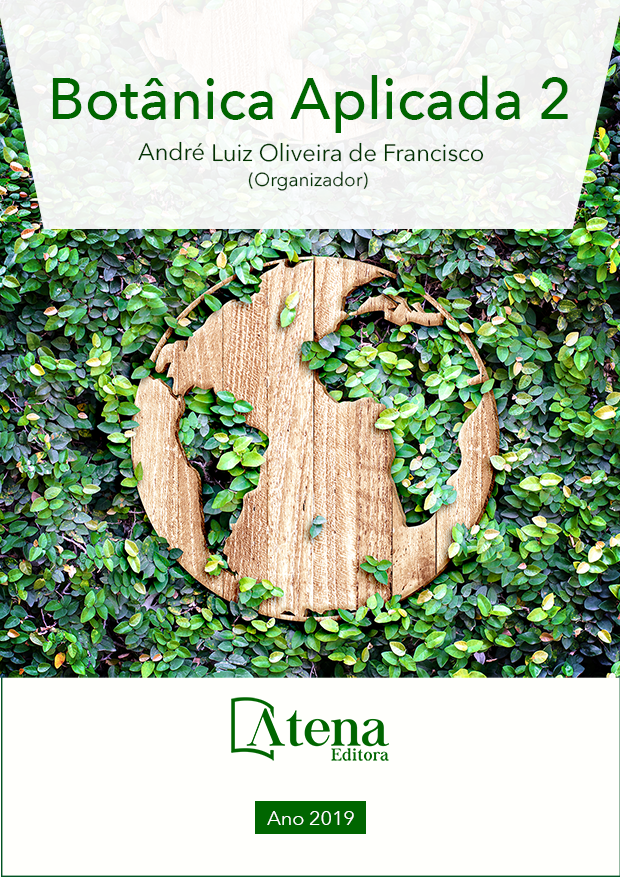
GERMINATION AND SEEDLING DEVELOPMENT OF THE GREEN FERTILIZER Canavalia ensiformis (L.) DC. (FABACEAE) UNDER DIFFERENT 2,4-D CONCENTRATIONS
O 2,4-D (ácido
2,4-diclorofenoxiacético) é um herbicida
extremamente tóxico e persistente no
ambiente, incluindo corpos d`água. O objetivo
deste trabalho foi avaliar a germinação e
desenvolvimento inicial de Canavalia ensiformis
sob diferentes concentrações de 2,4-D, aliando
os benefícios da fixação biológica de nitrogênio
e capacidade de fitorremediação. As sementes
foram desinfestadas e introduzidas em vasos
de Leonard modificados, contendo areia e
2,4-D: 0 (controle), 0.35, 2.48 e 4.97 mg/L. A
avaliação pós-germinativa foi feita considerando
a porcentagem de germinação; comprimento
do hipocótilo, epicótilo e da raiz; e, número de
folhas. A germinação foi observada a partir do
3º dia. Do 10º ao 17º dia a porcentagem de
germinação do controle se manteve em 10%,
enquanto nas concentrações de 2.48 e 4.97
mg/L, no 17º, a germinação alcançou 30 e 40%,
respectivamente. As plântulas do tratamento
controle apresentaram tamanho médio de 17.4
cm, 2 folhas e 8 cm de raiz. Com a adição de
2.48 mg/L de 2,4-D, as plântulas obtiveram o
crescimento médio 15.6 cm, 1.33 folhas e 7.1
cm de raiz. O 2,4-D mostrou efeito estimulador
da germinação de sementes de C. ensiformis.
O comprimento das plântulas foi maior no
tratamento controle do que sob efeito do 2,4-
D. Não se verificou alterações morfológicas no
desenvolvimento das raízes sob efeito de 2,4-D.
O plantio de C. ensiformis é uma alternativa para
fitorremediação de 2,4-D. No entanto, estudos
precisam ser feitos para verificar a tolerância
de C. ensiformis a maiores concentrações de
2,4-D e o mecanismo de fitorremediação deste
contaminante.
GERMINATION AND SEEDLING DEVELOPMENT OF THE GREEN FERTILIZER Canavalia ensiformis (L.) DC. (FABACEAE) UNDER DIFFERENT 2,4-D CONCENTRATIONS
-
Palavras-chave: agrotóxico, feijão de porco, herbicida, germinação, leguminosa
-
Keywords: pesticide, jack bean, herbicide, germination, leguminous
-
Abstract:
The herbicide
2,4-dichlorophenoxyacetic acid (2,4-D) is
extremely toxic and persistent in the environment,
including water bodies. This study aimed to
evaluate the germination and initial development of Canavalia ensiformis under different
concentrations of 2,4-D to determine its value as both green manure and potential
phytoremediate. Seeds were disinfected and introduced into a modified Leonard`s
vessel at concentrations of 0 (control), 0.35, 2.48 and 4.97 mg/L 2,4-D. Germination was
observed from the 3rd day. From the 10th to the 17th day, the percentage of germination
of the controls remained at 10%, while at the concentrations of 2.48 and 4.97 mg/L 2,4-
D, it was 30% and 40%, respectively. Post-germination parameters were performed on
the 17th day, including percentage of germination, length of hypocotyl, epicotyl and root
and number of leaves. Seedlings of control treatment had a mean length (hypocotyl +
epicotyl) of 17.4 cm, 8 cm of root and 2 leaves. At the concentration of 2.48 mg/L 2,4-D,
the mean length was 15.6 cm, 7.1 cm root and 1.33 leaves. Therefore, 2,4-D showed a
stimulative effect on the germination of C. ensiformis. Seedling length was higher in the
control treatment than other concentrations of 2,4-D. No morphological changes in root
development were observed as a result of 2,4-D exposure. Based on these results,
C. ensiformis appears to represent a novel alternative for phytoremediation of 2,4-D,
but further research is needed to determine the tolerance of C. ensiformis to higher
concentrations of 2,4-D and the mechanisms of phytoremediation of this contaminant.
-
Número de páginas: 15
- Carla Caroline Amaral da Silva
- Dora Santos da Costa
- Ida Carolina Neves Direito
- Cristiane Pimentel Victório


